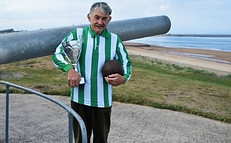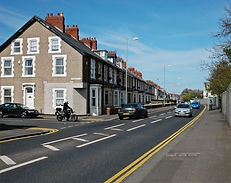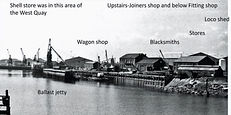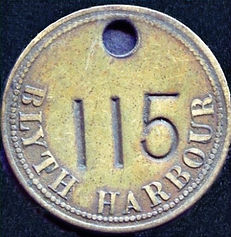

BLYTH BATTERY & HARBOUR
The historic Blyth Battery


Colin and Lindsay, at Blyth Battery, with a replica of the Munitionettes' Cup
(Image credit: Ewan Waugh)
If anyone is interested in sampling life during World War I (1914-18), we highly recommend a visit to the Blyth Battery, situated on South Beach in Blyth, Northumberland.
Now a wonderful museum, with free entry, the impressive array of six separate buildings acted as a lookout, armaments, storage and assembly point during World War I. Built in 1916, the battery also boasted two six-inch guns for coastal defence, guarding the mouth of the River Blyth in its North Sea location.
Lindsay Durward, secretary of Blyth Battery Volunteers, explained: "We are an enthusiastic group who maintain, conserve, research and open Blyth Battery to members of the public.
"We also put on displays commemorating the history of Blyth Battery at events around the region throughout the year."
Lindsay continued: "We're based in Links Road on South Beach in Blyth and have a high physical profile. We're also on the walking route between Blyth and Seaton Sluice, so it's really easy to pop in for a tour either as individuals or an organised group."
Blyth Battery Volunteers chairman, Colin Durward, added: "If people want to learn about the history of Blyth, we are always looking to welcome new members to our group. We have no minimum commitment; any help, no matter how small, would be welcome.
"It's amazing how many people come along and are so enthused by the place and the history that they want to get involved as a volunteer, either with the public or behind the scenes."
The battery relies on donations to preserve this crucial legacy of Blyth and Northumberland's WWI history.
Working life on Blyth Harbour

Blyth's South Harbour during World War I
(Image credit: Gordon Smith)
The photograph, donated by Gordon Smith, shows munitionettes at Blyth's South Harbour unloading the ammunition boxes full of spent cartridges salvaged from the front. Bella Reay and her Blyth Spartans Ladies teammates are likely to be among them.
Blyth was one of five salvage depots established by the Ministry of Munitions. The others were in Immingham (Lincolnshire), Manchester (Trafford Park), Renfrew (near Glasgow) and Ridham (Kent). The depots were used for the recovery, storage and sorting of cartridge cases, boxes, heavy artillery ammunition and anti-gas equipment.
Ships taking coal to France returned with salvage cartridge cases to Blyth.
The conveyor belt we see in the photograph would have started from a ship at the dock. The railway line in front would have been used by trains to convey the boxes to a shell repair and then filling factory on Tyneside (probably in Newburn) to be sent back to the front. Some ammunition would have gone to Blyth Battery, which guarded the coast.
Some of the boxes (perhaps those stacked high in the middle, left-hand side of the photo) were loaded onto wagons on Links Road and transported by road.
A closer look shows the women wearing clothes similar to the munitionettes pictured above. The photograph also includes a couple of men (far right-hand side). Given that the latter have their hands on their hips (no boxes in hand), they were probably supervisors.
It was back-breaking, manual work - carried out in all weather conditions. The winter of 1918 was particularly severe. In addition, used cartridge cases were dangerous because some still contained explosives.
Notice the house with the distinct windows in the bottom right-hand corner of the photograph. The house still exists today (see image below). It is on the corner of Chamberlain Street and Links Road/Wensleydale Terrace, Blyth.
On the street map, below, Blyth historian Gordon Smith has indicated (with red spots, right-hand side, middle) where the image was taken. It is marked as being in front of the site of the Royal Northumberland Yacht Club.


Blyth Harbour Commission tallies

Blyth Harbour tallies.
(Image credit: Gordon Smith)

Blyth Harbour workshop area in about 1984. The buildings annotated were built around 1914. The ballast jetty was built earlier
(Image credit: Gordon Smith)
Example of tallies used by the Blyth munitionettes during World War I. A personalised tally number would have been punched into the centre.
When anyone started work for the Blyth Harbour Commissioners (BHC), they were given a tally number. This would remain with them for as long as they were employed by the Commission.
A worker, before the start of the working day, would collect their tally from the time office before proceeding to their place of work. Time clocks and time cards were not used.
Each person had two tallies, one brass and one aluminium. On a Monday, the brass tally was issued, on Tuesday the aluminium one and so on.
The tallies were kept on a board in the time office, so that the storekeeper, who issued the tallies, would know who was at work and know if they had left the premises at the end of the day (when the tallies were handed in). It was a system similar to that used at the collieries.
The time office was in the stores, downstairs on the left side of the building, shown in the 1984 image on Blyth Harbour.

Brass tally No.115, Blyth Harbour
(Image credit: Gordon Smith)

Aluminium tally No.278, Blyth Harbour
(Image credit: Gordon Smith)
Tally No.115 originally belonged to William Allan, who was born in Chester-le-Street, County Durham, on 2 February 1873. William started work for the BHC on 8 April 1891 as a general labourer. He lived at 75 Northumberland Street, Blyth.
William worked at the port for three years and left to become a school caretaker on November 28, 1913. By 15 August 1919, he was back working at the port. We know this because his record shows he lost the end of his finger on that date!
The tally was reissued to Samuel John Doy (born Lowestoft, 24 August 1881) on 4 April 1923, a deckhand on the dredger Viscount Ridley. Samuel resided at 10 Arcadia Terrace, Blyth.
The tally was issued to another six people until the system fell into disuse in the 1980s.
By this time, the harbour had developed the former shipyard area as part of the port, and the workmen would start in different locations, including the former dry docks and the west yard of the old shipyard, known as Wimbourne Quay.
Tally No.278 was issued to Thomas Weir in September 1912. It belonged to Charles R. Wilkins from March 1914 until he left in September 1920, after serving an apprenticeship with the BHC as a fitter. It was last issued to R.H. Walker on 27 June 1949, when he started as a labourer.
The above information regarding the tallies is from BHC record cards that were used from 1915 until the records were transferred to a computer in the 1970s.
These record cards were not all transferred to a computer, but kept in the cellar of the old offices on Bridge Street, Blyth, and forgotten about - until two friends of Blyth historian Gordon Smith copied the details, which he transferred to a database.

